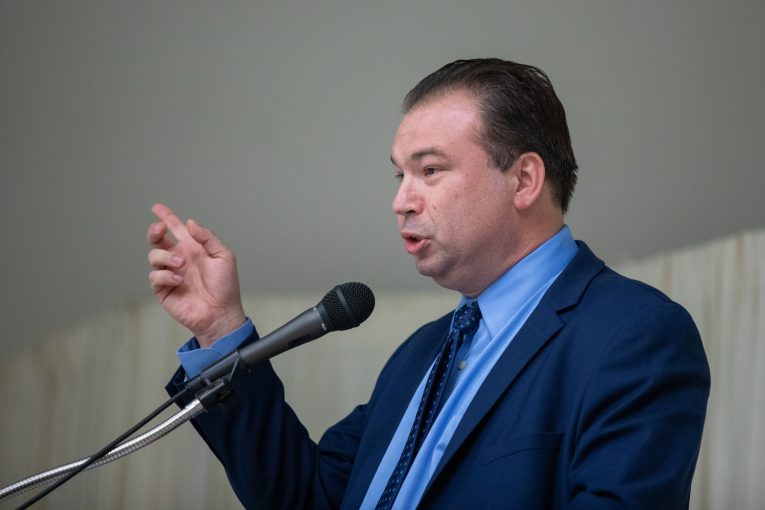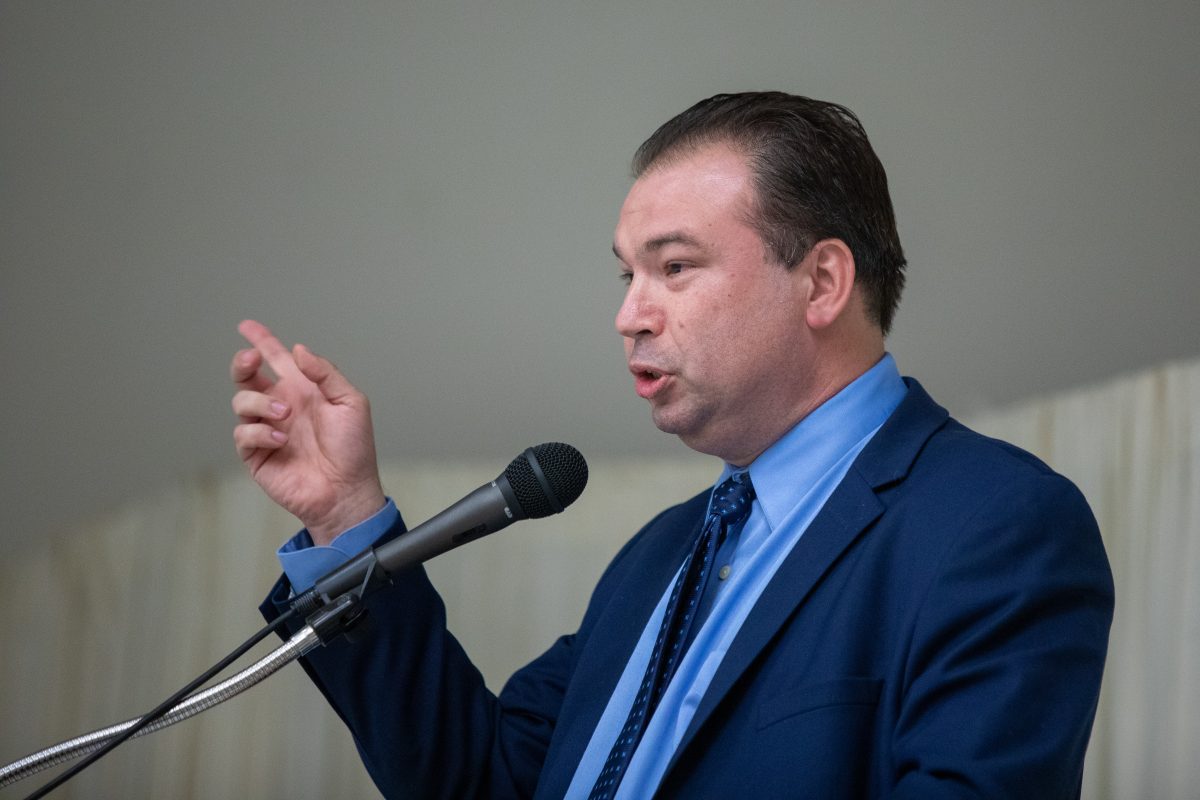

Mounting Evidence of Innocence
By Jeffrey Deskovic
“Looking back” will feature reprints of articles that Jeff previously wrote while a columnist at The Westchester Guardian, which encompass topics that are applicable here in CA as well as across the country and not simply applicable to NY.
FBI Fingerprint analyst Fosher testified that a latent fingerprint “of value” was found in the door frame that did not match Days, nor did one found on a roll of tape used to wrap a bag around Ramcharam’s head.
There had been prior testimony that a Caucasian hair was found on the victim’s sock, but no DNA materials were recovered at the scene that matched defendant Days.
The testimony of Magistrate Ramona McIver, now deceased, was read into the record via a reenactment, having previously been given in 2009 in front of Judge Jeffrey Cohen.
The magistrate stated that Selwyn Days and his mother were in her office in November 21, 1996, in North Carolina, because the mother was filing a complaint against Selwyn’s then-girlfriend for allegedly verbally threatening her the day before. The judge also had court records of the complaint which assisted her memory. She further stated that Selwyn was in her office “all the time,” was in and out every other day, and all throughout the month prior to the 21st in November. Asked whether she noticed any cuts or bruises on him, she replied, “No.” She was further asked, “Did he look nervous?” She replied, “No.” Cross-examined by the prosecutor on this point, the judge was asked, “No way you could tell without absolute certainty that he was there the 17th, 18th, 19th, and 20th?” She replied, “I could not.” The judge then added, “The whole month of November he was in and out of my office.”
In other testimony from the judge, she stated that Days “would give you the shirt off of his back,” referring to a time when the judge had a medical condition requiring her to drink a lot of water, and Days, without being  asked, brought her a large container of water. She also added, “He had some mental issues.”
asked, brought her a large container of water. She also added, “He had some mental issues.”
The prosecution then called Dr. Astrid to the stand to testify about Harris’ and Ramcharan’s injuries. Astrid herself had not examined the victims in 1996. In fact, they had been examined and autopsied by former Deputy Chief Medical examiner Dr. Luis Roh, who testified at both prior trials.
Despite her prior lack of involvement, in an unusual move, she was allowed to testify based upon Roh’s notes and her observation of several photos. Ordinarily, the medical examiner who personally viewed the body and authored the notes would be the one testifying. However, Dr. Roh went into retirement immediately upon learning of a civil action brought by a Westchester exoneree alleging that he engaged in fraud by fabricating results designed to benefit the prosecution in a rape/murder case tried in 1990. No doubt wishing to avoid bringing a vulnerable witness before the jury, the prosecution opted to have Dr. Astrid testify instead, and, for reasons that are unclear, the defense did not object.
Assistant District Attorney Perry Perrone handled her direct examination, as she outlined at length the stab wounds both victims had, at times supplemented by ghastly photos. Focusing on the time of death, she stated, based on rigor mortis science, the victims had been dead for two to three days before the bodies had been discovered.
Seeking to overcome any possible prejudicial impact by the introduction of the photos, and any undue elevation of the importance of her testimony generally, Glenn Garber attempted to bring back into focus by way of cross-examination the notion that the trial was not about whether a crime had been committed, but rather who committed it. “You cannot say who inflicted the wounds?” Astrid replied, “No.” “You cannot state if it was an African American or Caucasian who inflicted the wounds, can you?”Again she replied, “No.” “Is it fair to say you can’t tell if it was one person or multiple people?” Once again she responded negatively. Perrone, attempting to rehabilitate his witness, asked, “Are you ever able to tell how many people perpetrated a crime?” She answered, “No.” He further asked, “Are you ever able to tell who committed the crime?” Astrid replied, “No.”
Dr. Hunter, a veterinarian who had examined the body of Harris’ dog, was then called to the stand. In his “confession,” Days stated that he had kicked the dog. Harris testified that she found no evidence of external trauma to the dog.
The prosecution then rested, and the defense began putting on its case. The defense called Sandra Thomas to the stand. In the “confession,” Days claimed that Thomas was outside the Harris home in her car, (then) went up to the house walking in on him, seeing him full of blood, and said, “You are a butcher, you sliced and diced her,” and that he then accompanied her to an abortion clinic. Thomas testified that the only time they went to an abortion clinic together was sometime between 1985 and 1986, fully ten years prior to the Harris/Ramcharam (killings).
Judge Adam Seiden was the next witness called by the defense. In his “confession,” Days stated that he slept at his mother’s house after dropping off Thomas at the clinic. Yet he had no access to the house at that time because, as Judge Seiden testified, he had prepared a lease for Stella Days, Selwyn’s mother, in the fall of 1996, for her to rent the house to tenant Mark Moore. He had a receipt and business record, which assisted his memory and corroborated his story. On cross-examination, Assistant District Attorney O’Connor asked, “Despite the lease that you prepared, you don’t have personal knowledge of the comings and goings, or whether Mark Moore ever took up residence there?” Seiden, making a face, replied, “Of course not.”
Analysis
The defense team, by means of external evidence, continued to try to show that the confession is false by disproving various elements of it. Firstly, although Days said that he had kicked the dog, there was no evidence of that. Secondly, although Days said that he washed blood off of his hands in the sink, tests revealed that there was no blood in the sink. Thirdly, his statements regarding Thomas are also demonstrably untrue. Would she really have wanted him to accompany her to an abortion clinic covered in blood and after catching him stabbing the victims? Would she not have been frightened of him afterwards, and/or called authorities to report what she saw? Yet none of those things happened. If the Eastchester Police truly believed this element of Days’ confession implicating Thomas, would they not have been compelled to pursue her for failure to notify them of the crime? On this basis alone, it should be clear to anyone objective that the confession is false and the Eastchester Police knew it.
It would seem impossible that a man of Selwyn Days’ brain-damaged capabilities could have committed the crimes and not leave a trace behind.
It is unimaginable that the prosecution, with a straight face, continues to use a confession that is clearly false, particularly in light of the fact that Westchester District Attorney Janet DiFiore is a co-chair of Chief Judge Lippman’s panel studying wrongful convictions, and given her familiarity with false confessions.
“Jeffrey Deskovic, Esq, MA, is an internationally recognized wrongful conviction expert and founder of The Jeffrey Deskovic Foundation for Justice, which has freed 9 wrongfully convicted people and helped pass 3 laws aimed at preventing wrongful conviction. Jeff is an advisory board member of It Could Happen To You, which has chapters in CA, NY, and PA. He serves on the Global Advisory Council for Restorative Justice International, and is a sometimes co-host and co-producer of the show, “360 Degrees of Success.” Jeff was exonerated after 16 years in prison-from age 17-32- before DNA exonerated him and identified the actual perpetrator. A short documentary about his life is entitled “Conviction“, and episode 1 of his story in Virtual Reality is called, “Once Upon A Time In Peekskill“. Jeff has a Masters Degree from the John Jay College of Criminal Justice, with his thesis written on wrongful conviction causes and reforms needed to address them, and a law degree from the Elisabeth Haub School of Law at Pace University. Jeff is now a practicing attorney.





